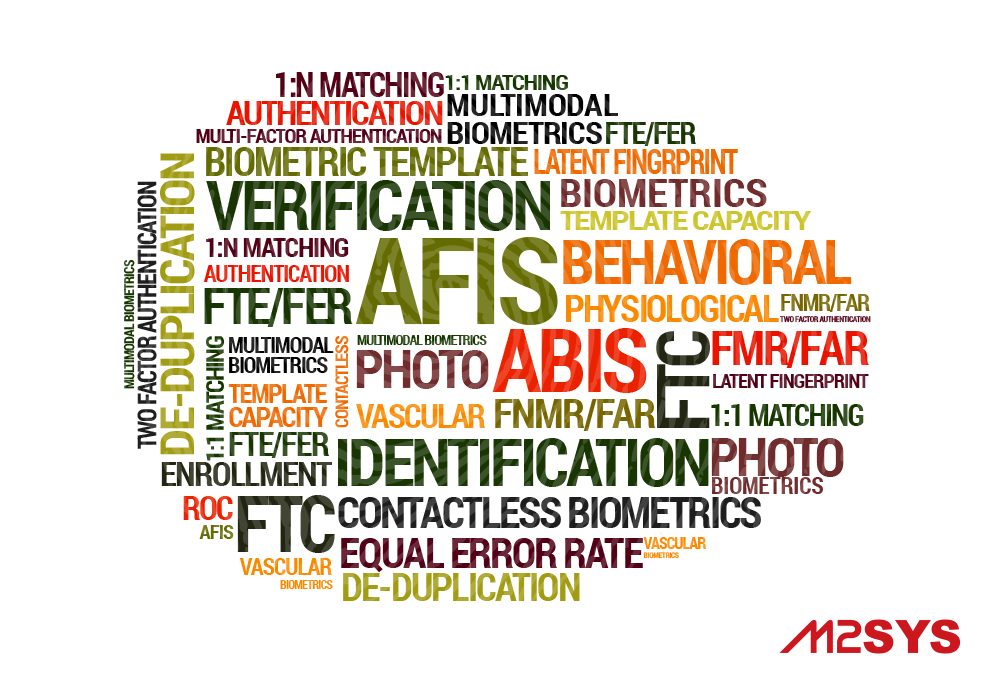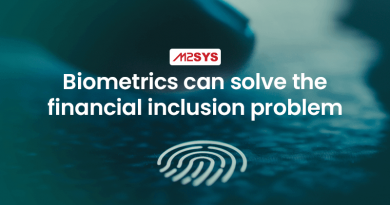The ABC’s of Biometrics: 25 Terms To Know
The following post was written by Mehedi Hasan, Executive (SEO/ SEM/ PPC) Business Development & Interactive Marketing at M2SYS Technology

As each day passes, the use of biometric identification management technology is becoming more popular in the modern world. Governments, businesses, religious organizations, and many others seek more reliable ways to achieve accurate individual identification, and many predict that it won’t be too long before biometrics expands into many more touchpoints in our lives from unlocking your cell phone to performing financial transactions.
You may have even occasionally run across biometric related terms around the web. These terms are becoming more commonplace as the technology accelerates in growth and plays a larger role in our everyday lives. However, some of these biometric terms may be confusing so we assembled a list of the 25 most common terms along with their definitions to help advance your understanding of how the technology works. We hope it will help you to better understand the biometrics industry:
- AFIS
AFIS refers to an Automated Fingerprint Identification System which is a method to analyze fingerprint data by digital imaging technology. It is most closely associated to access control systems and has a history of being based on fingerprints only. Though law enforcement agencies apply this method for criminal identification, it is now use in extensively for various purposes such as Voter ID, National ID, and border control.
- ABIS
ABIS stands for Automated Biometric Identification System which is also a large scale customizable software solution similar to AFIS, but with the added advantages of utilizing multiple biometric modalities including iris and facial recognition to provide fast, secure, and reliable results.
- Physiological Biometrics
Physiological biometric systems use parts of the human body for individual identification. (e.g. fingerprints, finger vein, facial or iris recognition).
- Behavioral Biometrics
Behavioral biometric systems identify individuals based on human actions and behaviors (e.g. keystroke dynamics, signature analysis, and gesture biometrics).
- False Accept Rate (FAR)
False Acceptance Rate (FAR) is a metric used to measure the accuracy of biometric systems to correctly or incorrectly identify individuals and demonstrates the chance of incorrect matches.
- False Rejection Rate (FRR)
When the system rejects an access mistakenly because of failing to match the biometric input with the template is called FRR or False Rejection Rate.
- Equal Error Rate (ERR)
Equal error rate or crossover error rate measures when acceptance and rejection errors are equal to each other.
- Failure to Enroll (FTE)
FTE used to describe when the biometric system fails to enroll a person’s biometric attribute due to various factors such as technical, environmental or damage due to accidental reasons.
- Failure to Capture (FTC)
FTC occurs when the system couldn’t detect a biometric input, even though it is correct.
- Template Capacity
The maximum capability of stored data in a biometric system.
- Multimodal Biometrics
Multi-modal biometrics is a system that uses more than one physiological or behavioral characteristic such as a fingerprint and finger vein for enrollment, verification, and identification of a person.
- Vascular Biometrics
Vascular biometrics uses near-infrared light to map vein patterns inside the human body within the finger or palm to capture the image of blood vessels for individual identification.
- Contactless Biometrics
 Contactless biometrics refers to biometric technology that can identify an individual without having to make physical contact with a hardware device (e.g. iris and facial recognition). It is considering extremely hygienic, especially in certain environments such as patient identification in healthcare.
Contactless biometrics refers to biometric technology that can identify an individual without having to make physical contact with a hardware device (e.g. iris and facial recognition). It is considering extremely hygienic, especially in certain environments such as patient identification in healthcare.
- Verification (1:1 Matching)
Biometric verification is an identity authentication process used to confirm a person’s identity by matching their uniquely identifiable biometric traits such as fingerprints, palm vein, iris, and face recognition with a specific stored biometric template.
- Identification (1:N Matching)
Biometric identification is the process of identifying a person by matching their unique biometric traits such as fingerprints, palm vein, iris, and face recognition with all stored biometric templates.
- Biometric Template
After a person’s unique physical or behavioral characteristics are captured by a biometric device, it is converted into a mathematical file using a complex algorithm and saved into the biometric database for future identification/authentication purposes. This file containing the mathematical representation of a person’s biometric trait is called a biometric template.
- Biometric Enrollment
Biometric enrollment is a process of collecting an individual’s unique physical or behavioral characteristics using biometric hardware which is converted into a mathematical file using a complex algorithm and saved into the biometric database for future identification/authentication purposes.
- Latent Fingerprint
A latent fingerprint is a type of fingerprint which cannot be detected by the naked eye but with special technologies can be captured, extracted, and used for individual identification.
- Biometric De-Duplication
Biometric de-duplication is a process of identifying duplicate biometric templates from the database to ensure every biometric template is unique.
- Multi-Factor Authentication/Two Factor Authentication
Multi (or two) factor authentication refers to a biometric system where more than one biometric credential is required to identify or authenticate a person. It increases the accuracy of biometric systems by an order of magnitude.
- Segmented identification (one-to-few, or 1: Few)
Segmented identification method involves confirming or denying a person’s claimed identity using a biometric scan followed by verbal confirmation to a general identification question (e.g., What is your date of birth?) or the entry of some known general information (gender, race, eye color).
- Biometric SSO (Single Sign On)
Single sign-on (SSO) is an independent software system which authenticates access with a single biometric attribute within the network.
- Iris Recognition
Iris recognition is a method to identify someone by a single iris or both irises (the colored, ring-shaped region surrounding the pupil of the eye).
- Palm Vein Recognition
Palm vein recognition is a vascular based biometric system identification method utilizing the vein pattern of one’s hand to create a unique template and to identify that person in the future.
- Finger Vein Recognition
Finger vein recognition is a vascular based biometric identification method which scans the veins inside the finger and generates an enrollment template based on that pattern for individual identification.
Conclusion
Biometric systems are fast becoming the default technology to provide the most accurate way to identify individuals. Biometrics has the potential to redefine and offer stronger protection for consumer privacy management. We hope these definitions of common biometric terms will help to clarify any misunderstanding of the technology and make it easier to understand and accept.
Need help understanding additional biometric terminology? Drop us a line at: info@m2sys.com













Pingback: Why Measure Employee Attendance with Biometric Time Clock